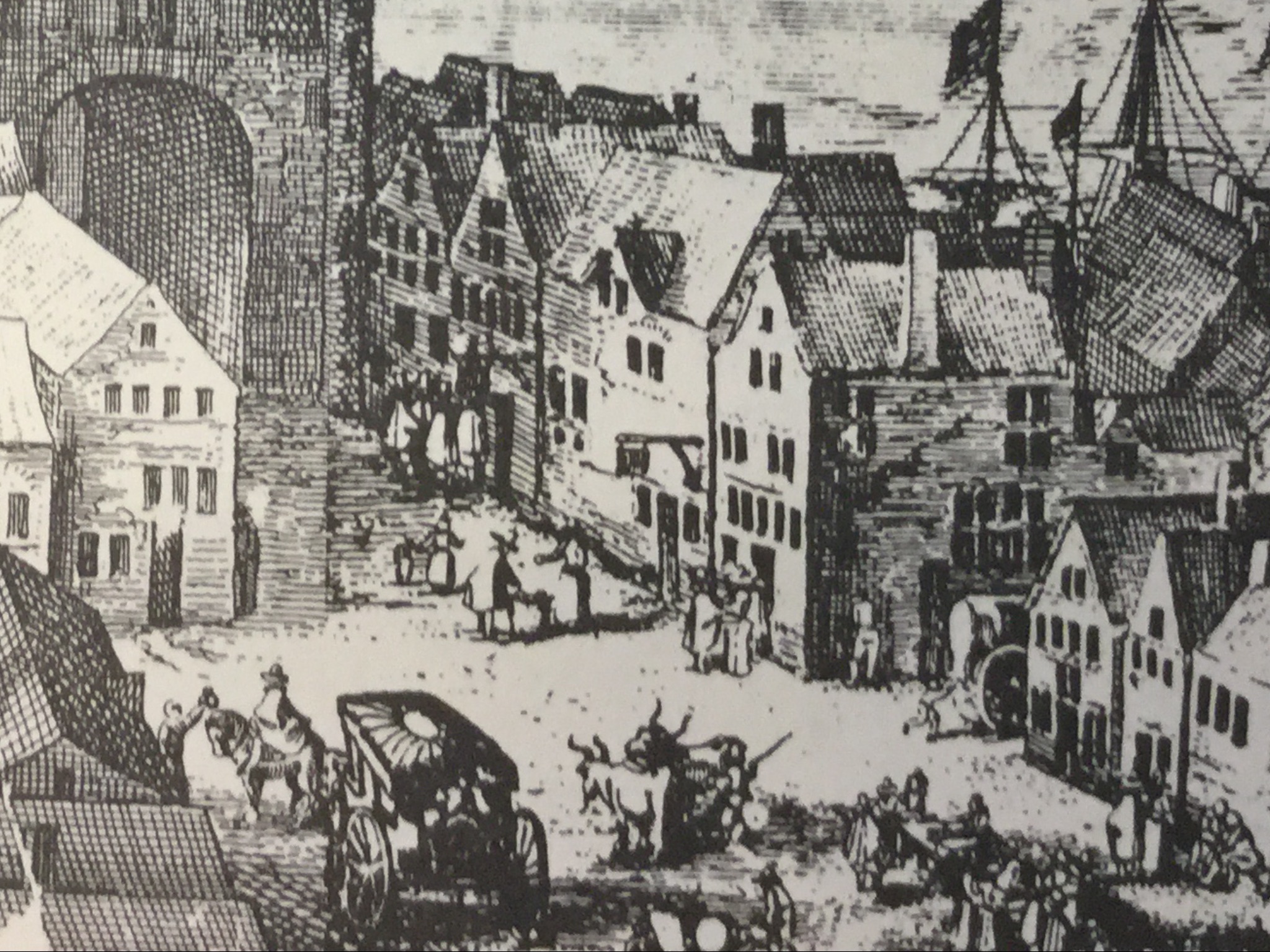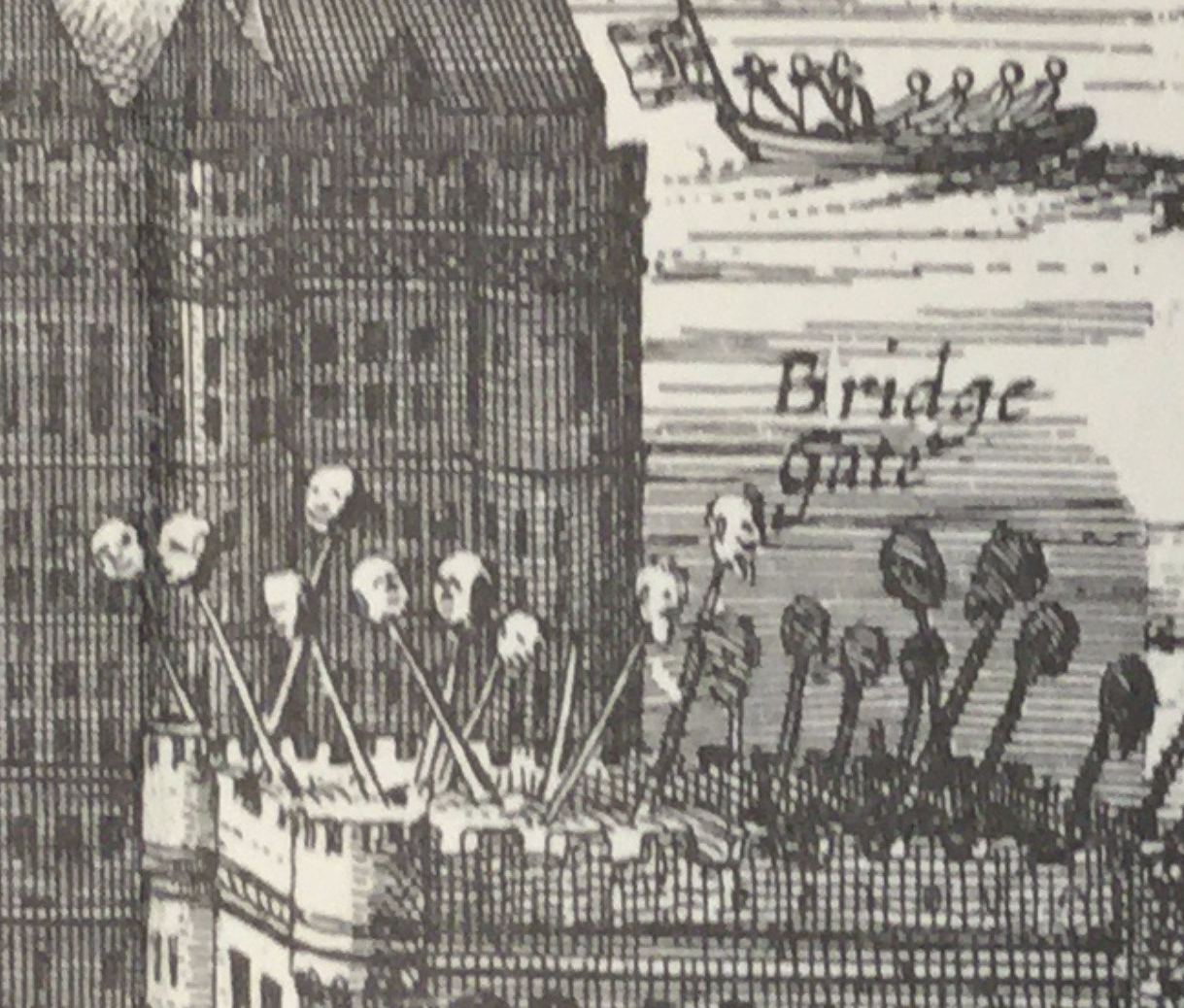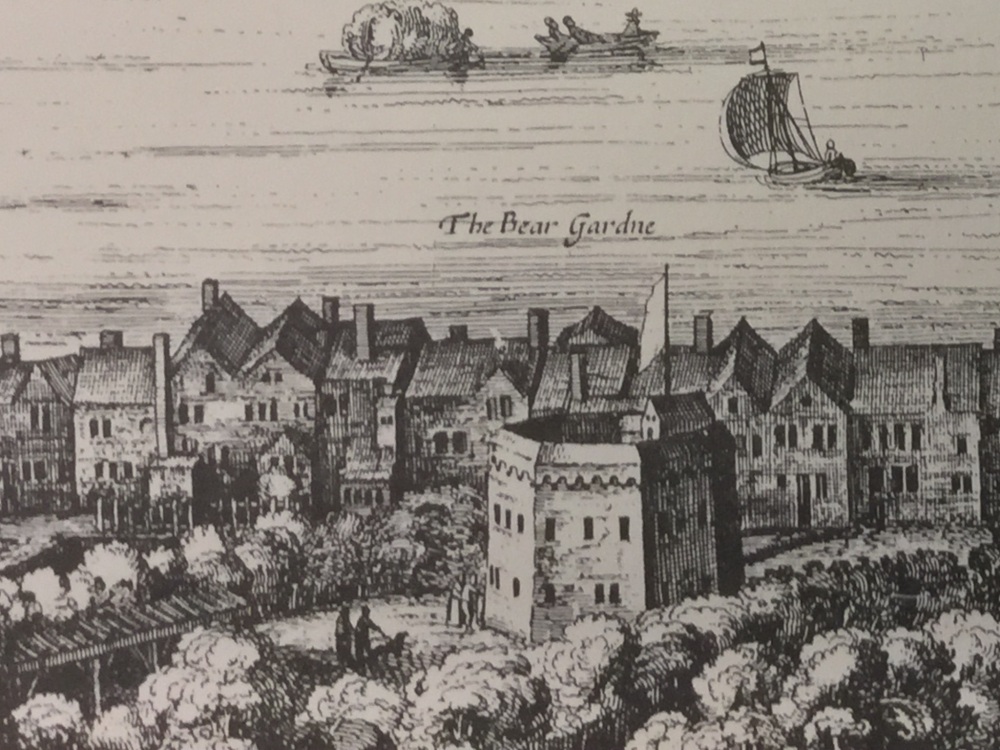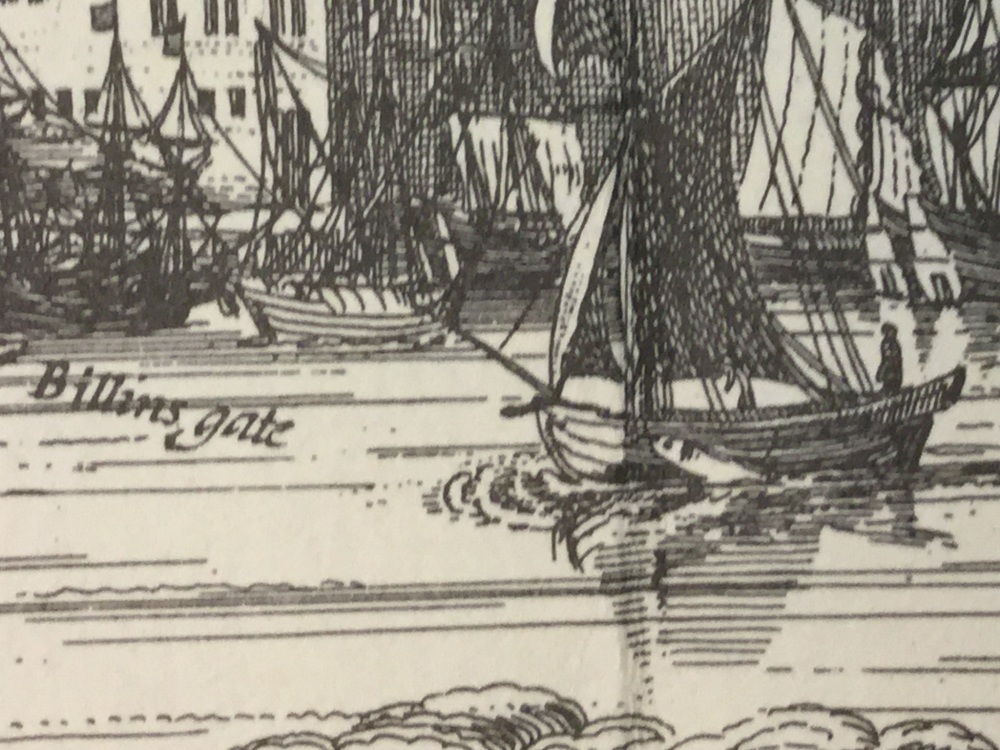Claes Visscher’s panorama of London is one of the most famous images of the City for many reasons. We see the various landmarks across London, such as the churches, Leadenhall and the Exchange, all of them labelled. Architecturally the panorama is superb, with the buildings drawn in great quality, detail and precision. It shows us London before the Great Fire of 1666, which destroyed much of what you see. This is the closest we can get to medieval London. Another enthralling and infamous fact is that Visscher never visited London, and drew the panorama from a view point that never existed. Yet the panorama is quite accurate. He obviously used other people’s work.
One thing that the panorama misses is activity. London was dense. It was packed full of people and there was a high demand for buildings, workshops, warehouses and living space. This demand encroached on any open space. Buildings were built high, close together and the streets were narrow. We get that impression in the picture from the architecture, but not from masses of people who lived and worked in London. In the panorama people are few and scant. Nonetheless, those that are there show an element of life. The drawn figures are quite generic, but there is movement within them that the eye automatically identifies and relates to. Their images display activity, pastime, work, wealth, poverty, fashion and uniform. They are quite intriguing.
South Warke
A famous area in the panorama is in the foreground by the south entrance to London Bridge. The eye is naturally drawn here. There are carts, oxen, a coach, people eating on benches outside an inn (denoted by the hanging signs), someone standing and facing the wall (are they pissing?). A couple almost embracing each other. A group of men huddle  outside what looks like another inn. They are fashionably dressed with knee length cloaks and wide brimmed hats. Are they businessmen or plotters? Interestingly, being here in Southwark, they are outside of the City of London and its jurisdiction.
outside what looks like another inn. They are fashionably dressed with knee length cloaks and wide brimmed hats. Are they businessmen or plotters? Interestingly, being here in Southwark, they are outside of the City of London and its jurisdiction.
The heads on London Bridge are rather nondescript, apart from one that looks happy to be there.
There are the people staring through the windows of the Globe theatre, getting a peek of a play for nothing. Not far away is the Bear Garden, with the kennels just next door. Two figures can just be made out with a dog straining on a lead, ready to face a bear perhaps. The kennels can be seen in the earlier Agas Map, a source that I use a lot. Considering Visscheur never saw London, perhaps he used it too.

Thamesis Fluvius
The Thames is busy with boats, although, again, I would say the River would have been far busier with river-taxis and trade all competing for space. The traffic gives a flavour of the 17th century Thames. There are the barges for the wealthy, displaying coats of arms, with their covered seating areas offering privacy. The rowers on the barges take the strain and pull back on the oars in unison.

Smaller boats carry cargo to and from smaller towns, such as Putney, or Kingston. Some appear too small for the hefty loads they carry. “Eell Schipes” have their nets full of eels, a staple, ready to sell. The Pool of London is busier, with larger craft arriving from or embarking to more distant ports in northern Germany, France, Venice connecting with routes penetrating far into the Asia.
The North Shore
It is the north bank of the Thames I find intriguing. This is the City where trade took place and the money was made. But this is not evident in the panorama. You can make out people along the shore, just in front of buildings. Perhaps it is because the panorama doesn’t represent the over-crowded bustling 17th century City of London, that these figures are more captivating.
Along the shore, there are wharfs, alley ways and steps descending into the river. Some landmarks are labelled, the Olde Swann, Queen Hithe, the Stilliarde. Next to Cole Harbour, a couple, a man and woman, sit on steps leading down from a courtyard. The man looks quite relaxed, leaning back with an air of taking things easy and enjoying the moment. She is hunched forward with a shawl around her shoulders. Her right arm raised as if in intense conversation. Next to them, a man carries two buckets, presumably of water taken from the Thames, up the steps to an open door. His shoulders are stooped as he carries his heavy load. What is the water for, domestic use, an industrial process? There is no indication of what the building is. One thing we can be certain of, it wouldn’t be for drinking. The Thames was not clean enough for that.

Next to “man with buckets” is a balcony with two people leaning on a balustrade, looking across the river. Someone has just appeared from an open door behind them. I’d like to think this is an inn and they are taking half an hour to enjoy the view across the river with a drink. Something I have done many a time.
Moving on downstream (below), two men carry objects from a small boat tied to the bottom of the steps. The man by the boat bends slightly forward with his arms in front of him, as he carries the goods up the stairs. The other has already reached the open door of the building. He is either just about to place the goods inside the building, or enter it himself, negotiating the narrow door way, bending his body to compensate for the awkward object.
Further towards Fishmongers Hall, people are getting out of a boat, perhaps a river taxi. One man helping his comrade or customer, to the shore. Another, racing ahead, disappears into the building at the top of the steps. Next to them, a man appears at the end of the alleyway, that leads to the river. Maybe he is about to call that river taxi when it finishes off-loading its customers.

Fishmongers Hall is the ‘hall’ for the Worshipful Company of Fishmongers, one of the ancient livery companies of London, a wealthy and powerful one. The hall was where their liverymen met, and business was carried out. In the panorama it is a large and significant building with the windows and decoration giving the impression of grand status. By the entrance two figures stand facing each other. They are wealthy judging by the clothes, perhaps he being a liveryman of the company. As they look to each other, they are close, their hands holding each other’s, or his upon her waist, in a similar pose to the couple in Southwark. I am intrigued as to why a couple may be showing affecting in such a public way, and on the steps of such an important institution. The behaviour is at a discord to the status of the building. I think again, we can look to Visscher’s naivety about London to explain this. He may not have even appreciated who the Fishmongers were.
I’ve taken a small stretch of the north bank here, but there is plenty more to investigate. Further upstream, the wharf, the Three Cranes, which has three cranes, has a number of people within it. They are meeting, shaking hands, facing one another, but the area itself looks void of life and activity. I wonder if the wharf is named after the three cranes. From my experience of 17th century towns, a ‘Three Cranes’ is usually an inn, and named after the bird whose habitat is of shallow wetlands, which was found on the

south bank, just opposite this point. Moving upstream to the Blackfriars area, more people can be seen, sat watching the River, throwing stones into it or waving. Some leaning over a fence looking into a garden or maybe they are gardening. They become smaller with perspective and lose definition.
One last thing
There is one figure in particular that caught my attention and captured my curiosity. He is on a boat in the Pool of London, immediately downstream from London Bridge. The boat is sailing, indicated by the ripples at the bow. No people are seen working on the boat, sailing it, controlling the sails or steering, which is surprising as it is about to either dock, turn-about or sail into the Bridge. Judging by the ripples at the bow, it is going quite fast. On the stern of the boat, facing backwards is a strong silhouette of a figure. He has a hat, not wide-brimmed, but more practical for a sailor, and a long coat. He appears to be staring, away from the direction of travel, into a distant space beyond the boat. I have no idea what this person is representing. It is at odds with the other figures, which although without detail, they make sense and give a certain feel of reality to the panorama. This one does not. Who is it, what is he doing? My only thought was, is it the artist?

References
The Visscher Panorama on London is featured in many books and websites. A simple search online will give plenty of information and images. A good high-resolution image can be found on Wikipedia.
http://www.panoramaofthethames.com/pott/visscher-pan/visscher-panorama
You can purchase copies of the panorama from high end second hand book/map sellers. Cheaper prints, but still good quality, can be found at places such as Guildhall Library.
Cranes
https://www.rspb.org.uk/birds-and-wildlife/bird-and-wildlife-guides/bird-a-z/c/crane/
Post-script
And finally, my version of the panorama, quickly taken just before a meeting, from a lower floor on the Shard, with a similar view on Visscher’s panorama.

What a fascinating post, I have always wanted to take more time time explore an important document like this, but have never managed it. Thank you for your close observation.
LikeLiked by 1 person
Thank you. Very kind of you to say.
LikeLike
I look forward to your next post.
LikeLike
Thanks for making me look more closely than I would have if left to my own devices.
LikeLike
Thanks for saying. I’ve recently discoverd that Visscher would put himslef somewhere in his art work. I think that chap standing on the front of the boat must be him. I’ve yet to update the piece.
LikeLike
Is it just me, or does the Thames look narrower in our time? Did they somehow figure out how build onto the water, like the Venetians?
LikeLiked by 1 person
Hello Librodidact.
You’re right, the Thames is more narrow today. This is down to general builing into the river over time, so that the Thames has become deeper and faster flowing. If you look at a map, say Google, at Lower Thames Street, in the Roman period, the River bank was in the middle of that road. Move to the Church of Saint Magnus-the-Martyr – that was on the river front dring the Medieval period. In the 19th century, Bazelgette laid down massive sewers which also encroached into the Thames.
It is not built in the same way as Venice, on wooden poles, but I often compare London to Venice.
Thanks for the comment
H
LikeLike
My apologies Librodidact, but being a history-archaeology geek, I am always directing people to resources etc. Take a look at this map of Roman London, overlaying the modern London. You’ll see the original northen river bank –
Click to access roads-to-rome-self-guided-walk.pdf
I am using it myself to give a tour on the trade and commerce of EC3 in the City of London.
LikeLiked by 1 person
Oh, this is fascinating, and I love it, thank you! I’ve recently taken to attempting a cohesive understanding of England’s history from pre-Roman times to present, and I very much enjoy this sort of thing. For instance, I recently learned about Doggerland, and I was captivated by the idea that there was once land that connected the British Isles to Europe. Thank you again!
LikeLike